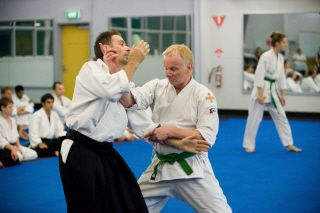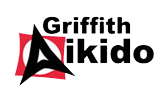Shukan News 28th Mar
Monday 28th March 2011
If you have any contribution for the Shukan News (story, photograph, video), please send it via email to gary@garyweigh.com
1. Safety part 3 – behaviour at class
 Self discipline and self control are two of the cornerstones of Aikido. Like any other martial art, Aikido starts and finishes with respect. These attributes, together with the expectations set out below, form the foundation of safe practice for everyone.
Self discipline and self control are two of the cornerstones of Aikido. Like any other martial art, Aikido starts and finishes with respect. These attributes, together with the expectations set out below, form the foundation of safe practice for everyone.
- Griffith Aikido institute Inc. exists to practice and foster the Art of Aikido. We believe that Aikido is for everyone. We do not discriminate on the grounds of gender, race, religion, sexuality, ethnicity, disability or age
- Our values include committed training, safe practice, loyalty and respect. That is, loyalty and respect to the dojo, instructors and each other
- Aikido is a highly participative art, learned by ‘doing’. Focus and concentration are required to practice effectively and safely. For that reason, you are encouraged to keep any talking during practice to a minimum, and any talking that is done should relate to Aikido
- Aikido skills are learned by cooperative practice. Unless otherwise instructed by your instructor, you should not resist techniques because part of your learning is feeling and experiencing the technique being applied and learning to go with the flow towards a safe outcome
- It is good manners to sit in silence while receiving instruction you’re your instructor. If you have a question, please do not interrupt, but ask it after Sensei has finished talking and demonstrating
- Inappropriate behaviour inside or outside the dojo, or on the mat will not be tolerated. This includes abuse, harassment (including sexual harassment), bullying and intimidation
- Wrestling on the mat or any other form of clowning around, roughhousing, horseplay or physical competitive behaviour will not be tolerated
- If you are practicing with a student who is lower in rank, you must practice to their level. That usually means going slower; not forcing the person into a forward or backward roll and not causing pain
- Everyone is different when it comes to applying wrist locks and pins. Be aware that many people are inflexible and cannot take much joint pressure. Apply pressure very slowly. Be alert to Uke tapping the mat or tapping them selves. This is your signal to release the pressure immediately. Joint lock pressure should never be applied to anyone under the age of 18 years.
- Griffith Aikido is a female friendly Aikido club. Please take care when practicing grabs and holds on females. Shoulder grabs are performed wide at shoulder level, not at lapel or chest level. A bear hug from behind is not a wrap around grab. It is performed just below the shoulders with hands joined and extended to the front
- Just as cooperative practice is the key to increased skill and competence, cooperation and teamwork gets the mats laid out, vacuumed and rolled up again.
2. The art of Nanba Walking by William Reed
Nanba is the Art of Physical Finesse. It begins with our most common form of movement, walking. Its applications range from martial arts, to dance, to music, to physical exercise.
7 secrets of Nanba Walking
- Turn without twisting
- Step with hands and feet together
- Connect your upper and lower body
- Step softly and swiftly
- Keep your feet in rhythm
- Take small steps with good alignment
- Practice walking to music
William Reed
http://www.EntrepreneursCreativeEdge.com
3. Thought for the week
Today, students of the martial arts have what can be called a “TV mentality”, turning off or changing channels whenever something fails to appeal to them. Instead of facing the challenge of training, they have become accustomed to simply tuning out or waiting for a better “show” to air.
‘KODO Ancient Ways, Lessons in the spiritual life of the warrior/ martial artist’ by Kensho Furuya (p45).
